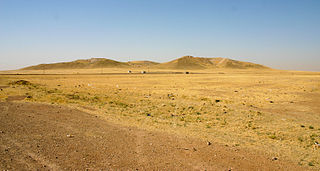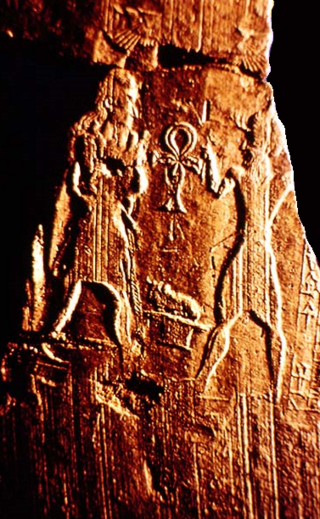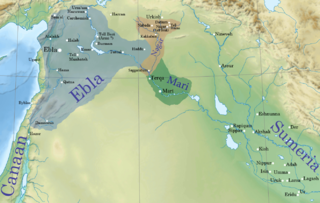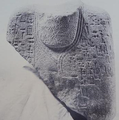
Yamhad (Yamḫad) was an ancient Semitic-speaking kingdom centered on Ḥalab (Aleppo) in Syria. The kingdom emerged at the end of the 19th century BC and was ruled by the Yamhad dynasty, who counted on both military and diplomacy to expand their realm. From the beginning of its establishment, the kingdom withstood the aggressions of its neighbors Mari, Qatna and the Old Assyrian Empire, and was turned into the most powerful Syrian kingdom of its era through the actions of its king Yarim-Lim I. By the middle of the 18th century BC, most of Syria minus the south came under the authority of Yamhad, either as a direct possession or through vassalage, and for nearly a century and a half, Yamhad dominated northern, northwestern and eastern Syria, and had influence over small kingdoms in Mesopotamia at the borders of Elam. The kingdom was eventually destroyed by the Hittites, then annexed by Mitanni in the 16th century BC.

Ebla was one of the earliest kingdoms in Syria. Its remains constitute a tell located about 55 km (34 mi) southwest of Aleppo near the village of Mardikh. Ebla was an important center throughout the 3rd millennium BC and in the first half of the 2nd millennium BC. Its discovery proved the Levant was a center of ancient, centralized civilization equal to Egypt and Mesopotamia and ruled out the view that the latter two were the only important centers in the Near East during the Early Bronze Age. The first Eblaite kingdom has been described as the first recorded world power.

Ibbit-Lim was the earliest known ruler of the Third kingdom of Ebla, in modern Syria, reigning most likely shortly before 1950 BCE.

Mari was an ancient Semitic city-state in modern-day Syria. Its remains form a tell 11 kilometers north-west of Abu Kamal on the Euphrates River western bank, some 120 kilometers southeast of Deir ez-Zor. It flourished as a trade center and hegemonic state between 2900 BC and 1759 BC. The city was built in the middle of the Euphrates trade routes between Sumer in the south and the Eblaite kingdom and the Levant in the west.
Irkab-Damu was king (Malikum) of the first Eblaite kingdom, whose era saw Ebla's turning into the dominant power in the Levant.

Tell Brak was an ancient city in Syria; it is one the earliest known cities in the world. Its remains constitute a tell located in the Upper Khabur region, near the modern village of Tell Brak, 50 kilometers north-east of Al-Hasaka city, Al-Hasakah Governorate. The city's original name is unknown. During the second half of the third millennium BC, the city was known as Nagar and later on, Nawar.
Armanum (Armänum) was a city-state in the ancient Near East whose location is still not clear, but it is believed to be in the same general area as Mari and Ebla. It is mentioned in the texts from the Akkadian period, specifically by Naram-Sin of Akkad. But the Akkadians were active in this region even earlier.
Tell Afis is an archaeological site in the Idlib Governorate of northern Syria, lying about fifty kilometers southeast of Aleppo and 11 kilometers north of the ancient site of Ebla. The site is thought to be that of ancient Hazrek capital of the Kingdom of Hamath and Luhuti. The Stele of Zakkur, dated c, 785 BC, which contains a dedication in Aramaic to the gods Iluwer and Baalshamin, was discovered at the top of the acropolis in 1903 by the French Consul Henri Pognon. It is now in the Louvre Museum.

Hotepibre Qemau Siharnedjheritef was an Egyptian pharaoh of the 13th Dynasty during the Second Intermediate Period.
Armi, was an important Bronze Age city-kingdom during the late third millennium BC located in northern Syria, or in southern Anatolia, Turkey, at the region of Cilicia.
The Ebla–biblical controversy refers to the disagreements between scholars regarding a possible connection between the Syrian city of Ebla and the Bible. At the beginning of the Ebla tablets deciphering process in the 1970s, Giovanni Pettinato made claims about a connection. However, much of the initial media excitement about a supposed Eblaite connection with the Bible, based on preliminary guesses and speculations by Pettinato and others, is now widely described as "exceptional and unsubstantiated claims" and "great amounts of disinformation that leaked to the public". In Ebla studies, the focus has shifted away from comparisons with the Bible, and Ebla is now studied above all as a civilization in its own right. The tide turned after a bitter personal and scholarly conflict between the scientists involved, and an alleged interference by the Syrian authorities on political grounds.

Indilimma, previously read Indilimgur, was likely the last king of Ebla, in modern Syria, reigning around 1600 BCE.
Vizier, is the title used by modern scholars to indicate the head of the administration in the first Eblaite kingdom. The title holder held the highest position after the king and controlled the army. During the reign of king Isar-Damu, the office of vizier became hereditary.
Iblul-Il was the most energetic king (Lugal) of the second Mariote kingdom, noted for his extensive campaigns in the middle Euphrates valley against the Eblaites, and in the upper Tigris region against various opponents, which asserted the Mariote supremacy in the Syrian north.
Ansud, was an early king (Lugal) of the second Mariote kingdom. Ansud is known for warring against the Eblaites from a letter written by the later Mariote king Enna-Dagan.
Ishtup-Ishar (Ištup-Išar) was a king (Lugal) of the second Mariote kingdom. The king's name was traditionally read as Išhtup-šar, with šar being a common divine element in personal names attested in the region. However, the king's name is read as Ishtup-Ishar by Alfonso Archi, Ishar being an important justice deity worshiped in Mari and Ebla.
Isar-Damu, was the king (Malikum) of the first Eblaite kingdom. Isar-Damu fought a long war with Mari which ended in Eblaite victory; he was probably the last king of the first kingdom.

Igrish-Halam or Igriš-Halab was a king of the ancient city state of Ebla. His name means "(The god of) Halab has driven away ", hence, the name might be a commemoration of an Eblaite victory that led to the incorporation of lands beyond the city of Halab.
Hadabal was a god worshiped in Ebla and its surroundings in the third millennium BCE. He was one of the main gods of that area, and appears frequently in Eblaite documents. His character is not well understood, though it has been proposed that he might have been an agricultural or lunar god. Like the city's tutelary god Kura and his wife Barama, he is absent from sources postdating the destruction of Ebla.













